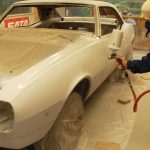In the expansive realm of DIY projects and automotive refinements, mastering the intricacies of painting over epoxy primer is a pivotal skill. This comprehensive guide goes beyond the basics, offering an in-depth exploration of the step-by-step process. It addresses common concerns, provides valuable tips, and ensures you’re well-equipped to achieve not just a finish but a masterpiece.
Introduction
Epoxy primer has risen in prominence, becoming a favored choice for its unmatched durability and resistance to corrosion. The allure of this bonding agent lies not just in its protective properties but in its ability to serve as an ideal canvas for subsequent layers of paint. The burning question for many enthusiasts embarking on a painting project is: Can you paint over epoxy primer? The resounding answer is affirmative, and this guide aims to demystify the process, making it accessible to all.
Understanding Epoxy Primer
Unraveling the Chemistry
Epoxy primer, with its unique chemical composition, forms a resilient foundation for paint application. Comprising epoxy resin and a curing agent, it not only fortifies surfaces but also enhances adhesion. This synergy between the primer and paint layers ensures a lasting and visually appealing finish.
Benefits Beyond Adhesion
Beyond its adhesive prowess, epoxy primer acts as a barrier against rust and corrosion. It seals surfaces, preventing moisture and other environmental factors from compromising the integrity of underlying materials. This dual functionality makes it an indispensable component in the world of automotive restoration and DIY projects.
Materials You’ll Need
- Epoxy Primer: The cornerstone of your project; choose a high-quality primer suitable for the specific material you’re working on.
- Sandpaper: An array of grits for the meticulous sanding process, ensuring the surface is receptive to the upcoming paint layers.
- Cleaning Solvent: An essential for removing contaminants and ensuring a pristine surface for paint adhesion.
- Paint: The star of the show; select a paint that not only complements the epoxy primer but is also suited to the project’s demands.
- Masking Materials: Safeguard areas that should remain paint-free, allowing for precision in your application.
Step-by-Step Guide
1. Surface Preparation: A Clean Canvas
Commence your project by diligently cleaning the epoxy primer surface. The use of a cleaning solvent will rid the surface of any grease, dirt, or contaminants that could compromise the paint’s adhesion.
2. Sanding the Primer: The Art of Texture
Sanding takes center stage, serving a dual purpose. Not only does it smooth the surface, but it also creates a subtle texture, enhancing the paint’s grip. Choose fine-grit sandpaper and, with a gentle touch, work your way across the primed surface. Wipe away the resulting dust with a clean cloth to reveal the canvas ready for its next layer.
3. Choosing the Right Paint: A Symphony of Colors
Selecting the right paint is akin to choosing the right notes for a musical composition. Harmonize the type of paint with the epoxy primer to ensure compatibility. Different materials may require specific paints, so take this into account for an optimal outcome.
4. Primer Compatibility Test: A Prelude to Painting
Before committing to the entire canvas, perform a small compatibility test in an inconspicuous area. This precautionary step ensures that the chosen paint adheres seamlessly without any unexpected reactions.
5. Applying the Paint: The Brushstroke Ballet
With your materials in place, it’s time to apply the paint. Whether you opt for a spray gun or a brush, the key is uniformity. Follow the manufacturer’s instructions regarding drying times between coats, allowing each layer to settle before progressing to the next.
6. Additional Coats: Building Layers of Brilliance
The number of coats depends on your desired finish. Applying multiple thin coats ensures an even and professional-looking result. Be patient, allowing each coat to dry thoroughly before adding the next layer of brilliance.
Tips for a Flawless Finish
- Patience is Key: Rushing through the process may compromise the outcome. Allow each layer to dry completely before proceeding to the next.
- Consistent Pressure: Whether using a spray gun or a brush, maintaining consistent pressure is pivotal for an even finish.
- Ventilation is Crucial: Adequate ventilation not only dissipates fumes but also expedites the drying process, contributing to a quicker project turnaround.
- Avoid Thick Layers: The mantra here is thin and even. Thick layers may lead to dripping and an uneven surface.
Common Concerns
Can You Paint Over Old Epoxy Primer?
Indeed, you can, but thorough surface preparation is paramount. Remove any loose or peeling paint, sand the surface, and follow the aforementioned steps for a seamless transition from old to new. (See Also: Can You Plasti Dip in Cold Weather? Tips for Cold-Weather Plasti Dipping)
How Long Should Epoxy Primer Cure Before Painting?
While the specifics may vary, a general guideline is to allow the primer to cure for at least 24 hours before applying paint. Always defer to the manufacturer’s recommendations for optimal results.
Expert Tips for Perfectly Painting Over Epoxy Primer
Achieving a flawless finish when painting over epoxy primer requires finesse and attention to detail. Here are expert tips to elevate your painting game and ensure your project stands out.
1. Master the Art of Surface Preparation
Before reaching for the paintbrush, invest time in thorough surface preparation. Cleanliness is key; remove any contaminants with a high-quality cleaning solvent. This ensures an immaculate canvas for your paint to adhere to.
2. Sanding: The Foundation of Texture
Don’t underestimate the power of sanding. Use fine-grit sandpaper to create a subtle texture on the epoxy primer. This not only enhances adhesion but also contributes to a smoother and more professional-looking finish.
3. Choose Paint Wisely
Selecting the right paint is half the battle won. Ensure compatibility with the epoxy primer and consider the specific demands of your project. The right paint not only enhances aesthetics but also contributes to the longevity of the finish.
4. Perform a Primer Compatibility Test
Avoid surprises by conducting a small compatibility test before painting the entire surface. This precautionary step ensures that your chosen paint interacts seamlessly with the epoxy primer, preventing any unexpected reactions.
5. Layering Techniques for Brilliance
Opt for multiple thin coats rather than a single thick layer. This not only allows for better control over the finish but also ensures even drying and minimizes the risk of drips.
6. Patience Pays Off
Rushing the drying process can compromise your hard work. Exercise patience between coats, allowing ample time for each layer to dry completely. This is the key to a smooth and professional-looking outcome.
7. Consistency in Application Pressure
Whether using a brush or a spray gun, maintaining consistent pressure is crucial. Varied pressure can lead to uneven application, affecting the overall finish. Practice consistency for a polished result.
8. Optimal Ventilation is a Must
Ensure your workspace is well-ventilated. Adequate ventilation not only helps dissipate fumes but also accelerates the drying process, facilitating a quicker project turnaround. (See Also: Can You Clear Coat Over Primer? A Comprehensive Guide to Achieving a Flawless Finish)
9. Precision with Masking Materials
When protecting areas from paint, invest in quality masking materials. Precision in masking ensures that only the intended areas receive the paint, contributing to a cleaner and more professional finish.
10. Fine-Tune Your Technique
Every painter develops a unique technique. Experiment with different strokes, angles, and application methods to find what works best for you. Fine-tuning your technique adds a personal touch to your projects.
Incorporating these expert tips into your painting process will not only enhance the longevity of your finish but also elevate the visual appeal of your projects. Remember, painting over epoxy primer is a craft, and mastering it takes a blend of skill, knowledge, and a touch of artistic flair.
FAQs: Unraveling Mysteries About Painting Over Epoxy Primer
Embarking on a painting project over epoxy primer often sparks a multitude of questions. Let’s address some common queries to ensure you navigate the process with confidence and expertise.
1. Can You Paint Over Epoxy Primer Directly?
Absolutely! Epoxy primer serves as an excellent base for paint. Ensure proper surface preparation by cleaning and sanding for optimal adhesion.
2. How Long Should I Wait Before Painting Over Epoxy Primer?
Allow the epoxy primer to cure for at least 24 hours before applying paint. Refer to the manufacturer’s guidelines for specific curing times.
3. Can I Paint Over Old Epoxy Primer?
Yes, you can. Remove any loose or peeling paint, sand the surface, and follow the standard painting process for a seamless result.
4. What Type of Paint Should I Use Over Epoxy Primer?
Choose a paint compatible with epoxy primer. Acrylic and urethane paints are popular choices, but always check for compatibility with your specific primer.
5. How Many Coats of Paint Should I Apply?
Opt for multiple thin coats rather than a single thick layer. This ensures even coverage, prevents drips, and contributes to a professional-looking finish. (See Also: How Much Fluid Film to Undercoat a Truck? Essential Tips for Effective Rust Protection)
6. Do I Need to Sand the Epoxy Primer Before Painting?
Yes, sanding is crucial. Use fine-grit sandpaper to create a textured surface, promoting better paint adhesion and a smoother finish.
7. Can I Paint Over Epoxy Primer Without Cleaning It First?
Cleaning is essential. Use a suitable cleaning solvent to remove grease and contaminants, ensuring a pristine surface for paint application.
8. What If the Paint Reacts Adversely with the Epoxy Primer?
Perform a small compatibility test in an inconspicuous area before painting the entire surface. This helps identify any potential adverse reactions between the paint and primer.
9. Is Ventilation Important During the Painting Process?
Absolutely. Adequate ventilation helps dissipate fumes and accelerates the drying process. A well-ventilated space contributes to a smoother and more efficient painting experience.
10. Can I Use Epoxy Primer for Non-Automotive Projects?
Certainly. Epoxy primer’s versatility extends beyond automotive applications. It can be used on various surfaces like metal, wood, and fiberglass for both practical and artistic projects.
Navigating the nuances of painting over epoxy primer becomes more straightforward when armed with answers to these frequently asked questions. Whether you’re a seasoned DIY enthusiast or a novice painter, understanding the essentials ensures your project unfolds seamlessly and with professional flair.
Conclusion
In the captivating realm of painting over epoxy primer, success lies in the details. This guide, a compendium of knowledge and practical tips, equips you to embark on your painting journey with confidence. Whether you’re a seasoned DIY enthusiast or a novice venturing into the world of automotive refinements, attention to detail, patience, and a dash of creativity will ensure that your project transforms into a masterpiece. Let your brushes dance, and may your finishes be flawless.



